HMS Bristol’s White Ensign was lowered for the last time at a decommissioning ceremony in Portsmouth.
The Type 82 Destroyer was commissioned in March 1973.
According to a Royal Navy news release:
“Designed to defend a class of aircraft carriers which were never built, Bristol was the sole Type 82 destroyer delivered to the Royal Navy and, until now, its second oldest commissioned vessel thanks to a unique career. Bristol notably saw action in the Falklands during 1982. Initially leading a group of two destroyers, five frigates and one RFA supply ship arriving as reinforcements, the ship later joined the carrier battle task group to fulfil her primary role as an air-defence destroyer and then assumed flagship duties.”
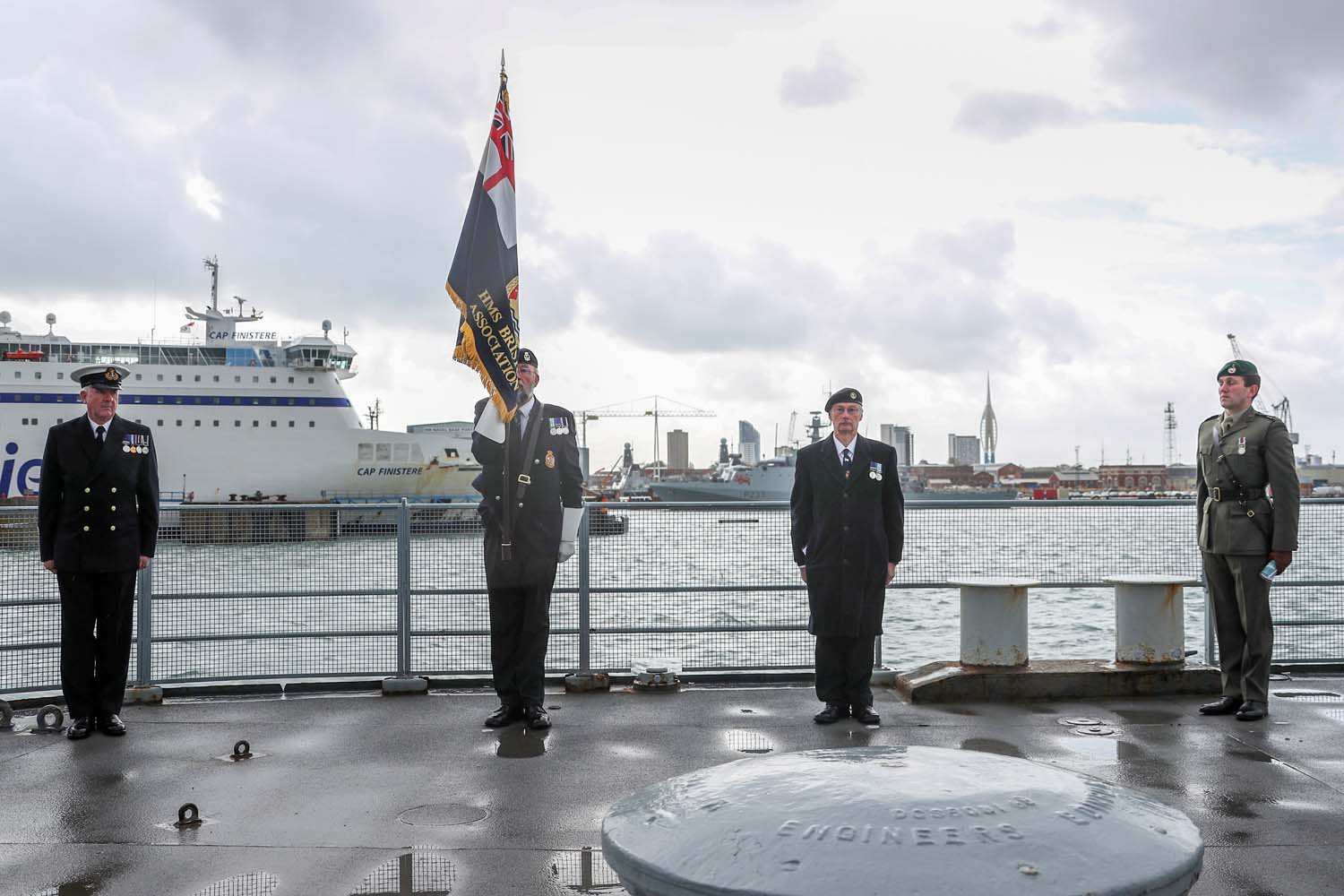
Her final Commanding Officer, Lieutenant Commander David Price, said:
“We knew the day HMS Bristol decommissioned from the Fleet would come, so it is my privilege as her final Commanding Officer to lower the White Ensign for the last time on behalf of the thousands of sailors and cadets for whom this ship has been an invaluable training platform, and also for all those who served on board during her first commission.”
After nearly two decades at sea, Bristol was re-commissioned and converted to a harbour training ship in 1993, remaining alongside at Whale Island ever since.
During that time, the Royal Navy say that the ship has provided a training environment for a wide variety of trainees; it has not been unusual to find engineering technicians training in machinery spaces whilst military training personnel conduct armed searches and medical assistants exercise casualty evacuations nearby.


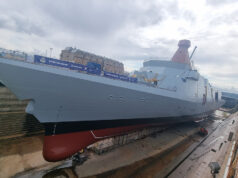


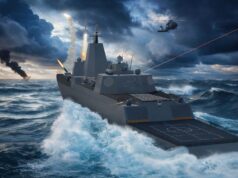
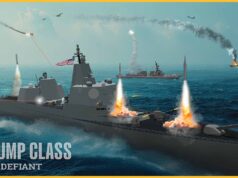
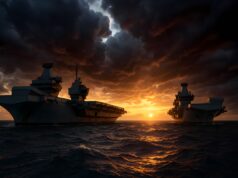
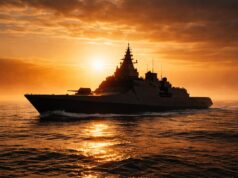

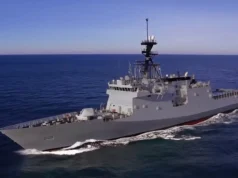

As a static training vessel for almost 30 years I imagine she would require a lot of work at significant cost to change her back into a Cold War era representation.
I wonder if we’ll see a T23 replace her as the training vessel. Would they be suited to that kind of role or are they too cramped? The first is due to decommission in 2023 but not sure what sort of condition they’ll be in after 30+ years of hard work.
Any pics from inside her, would be interested to know how intact she is.
Inside the ship is in good order being kept clean painted by the trainees
Apologies for going off topic, but i couldn’t resist
https://www.janes.com/defence-news/news-detail/uk-bars-south-korea-from-selling-fa-50-to-argentina
LOL
With the supposed state of their economy, rather surprised that they can afford them in the first place!
Bad as always but they would have been purchased via a loan from the South Koreans.
In the end you will be hard pressed to find any Western made fighter jet that doesn’t have some UK produced components or those based upon UK IP and needing an export licence.
Good point, hadn’t really considered that angle, expect they would have made more from any support contract that would probably be part of the deal! Cheers.
Pretty normal in the world of defence sales, the Government of the nation selling the fighter jet is acting as guarantor for the deal whilst the banks are lending the money. The factories within the selling nation then have work and a customer that is locked in for two to three decades of on ongoing support contracts. Even with offsets it is a pretty good deal for the selling nation.
One for me to file away for future reference, tavm for explanation.
Many thanks very interesting. Staying off topic can people start looking at CANZUK sounds an interseting idea
Interesting, soz
Not really off topic. Bristol was in the South Atlantic opposing the Argentinians was she not? Argentina would not be facing the embargo if it were not for that conflict and their continued insistence that the Falklands somehow belong to Argentina.
It’s a shame, She was built with a relatively narrow beam of only 17m, which would of limited the amount of top weight she could carry like radar systems.
Well that was the RN ‘speed above all else‘
The combine with the long thin -> greater speed arguments.
Speed was mandated on the old short carriers by wind over deck considerations and the increasingly heavy jets.
There you put you finger on why high mounted area search was possible until the T45.
When the T82 and to a certain extent the T42 was conceived the 3D search radars were supposed to be on the carriers.
What was interesting was the the Invincible’s initially didn’t have 3D radar: old Eagle did have.
The oddity continues with the QEC’s not having Samson on their very high mast: in spite of their massive beam. As I’ve speculated before the reason I suspect Sampson was not put on QEC’s was that it would have lead to a ‘you don’t need Crows Nest then – do you?’ conversation.
It is a shame as I do think that a super high Sampson would have added quite a lot when combined with Crows Nest. The only thing I would observe is that carrier radar is generally used passively so as not to give location of the main asset away.
Most of the sky can be seen from low down, so why not have a big 3D radar low down and a small 2D radar really high up and looking at just the horizon?
She was designed to be a lot heavier than she actually was.several systems were never fitted likewise much of the stuff still on her is beyond obsolete but would allow for the fitting of newer equipment
Maybe it’s time to re-introduce the Type 8X general purpose destroyer. Now that we are operating strike carriers again.
is even 10000 tonnes too small?
F8r that possibly read T26 destroyers
With upcoming introduction of hypersonic and ballistic ship killing missiles the Royal Navy next Royal Navy destroyers are going to be very large to carry defensive and offensive weapons that are expected to include rail guns, laser weapons beside the current standard armaments of main guns, close I defense guns, air defense missiles, anti ship missiles and anti submarine missiles plus vertical take off and landing aircraft (helicopters and drones).
In my opinion the best way for the RN to go is to order a new class of large destroyed in the 10-15k tons class counter the Chinese Type 55 class sized destroyer/cruisers that China and Russia are fielding. I think the RN should develop a standard destroyer based on an enlargened Type 26 to replace the Type 45 and the build a new class to be classified as Cruisers that will have an anti ballistic missile capability and an arsenal ship with over 100 VLS tubes, a two gun turret of a155mm gun and rail gun like the Sum salt arrangement, laser guns, and array of requisite close in self defense wraps and of 57mm and 40mm calibre.
Just my two cents. Numbers to be built, say 6 in addition to 6 Type 45 replacements.
Where is the RN going to find the money for such ships?
@ MarK – Hello Sir. I believe the Type 45 will need replacing in the next 15-20 years. My idea is that focus on the Cruiser type ship start now. Most of the equipment for this ship are already available in the Royal Navy or USN. The Mark 57 VLS on the Zumwalt Destroyers would be suitable for the proposed Cruiser. Navalized 155mm gun is produced by BAE for the USN. BAE also has a Rail Gun prototype that has been in testing for a decade. Laser weapon systems we are told are being built for testing next year. The PAAMS anti-ballistic missile system from MBDA is available, failing that Raytheon is has a number of Standard missile offerings. Combat systems are available from BAE, Babcock or Lockhead (Aegis). Radars either updated SAMPSON from BAE or SPY 6 from Raytheon are in production.
So in terms of cost there is a lot of off the self products. A multi ship order could help keep costs down especially if syncronised with USN purchases for items such as the Mark 57 VLS etc. Financing purchases by the Treasury for new or additional systems to protect the UK carriers and maintain an expeditionary will have to be done some time in the near future, so it is a matter of MoD and RN working to put together a procurement plan that allows for a purchase of an initial 2 ships for the cost of the 1 carrier, £3 billion, over a 10 year period. That I estimate is an additional £300 million per year to the defense procurement budget
UK’s £1.3 trillion economy can be expected to grow at the minimum 0.5% to 1% per annum over the next 10-15 years thus adding at the minimum is £6.5 billion annually to the UK economy. My suggestion is that 2-4% of this annual growth (depending on GDP growth) be added to the naval procurement budget for these Cruiser that are necessary if the RN and the political master are still thinking of maintaing a Global Britain.
Getting these cruisers out of the way early will leave room for the Type 45 replacements (essentially Type 26 air defence variants or event Type 31) from the 2035 onwards time frame.
Considering you also have to replenish the equipment of the Army and trying to get Tempest operational and maybe more 35s…Still don’t see where you get the money for such growth in the RN tbh.
Don’t need a cruiser it would mean you have to reduce order sizes for existing classes
It is not going to find the money. My guess is 4 T4X to replace the 6 T45s and nothing else. Also SSNs probably down from 7 to 6 with the successor to Astute. All very well for politicians and the media to pontificate about ‘global Britain’ to hoodwink the electorate but actually funding these lofty ideas is a different matter entirely.
Building less SSN or T4x saves nothing IRL.
R&D costs then dominate the production unit costs.
You just have a tiny number of units that are worked very hard and get knackered very quickly. And that dominates the availability stats.
With the tiny crews now onboard ca 1/2 – 1/3 of Cold War crews the staff running costs are not the dominant factor they used to be.
Critical mass is the factor you are looking for where the cost of R&D, shore training facilities, support and supply chains become problematic for tiny establishments. Economics actually drives slightly larger classes of ship which is why I’m surprised that T31 is just 5 not 8.
I think it is more likely that T4x will also be 8 units. There is little special about the T45 hull or propulsion and the shell could and should have been designed and built a lot cheaper. The only was the T4x is a smaller class is if it is very closely related to something else. But as we have been over, as nauseas, the T31 is not suitable and the T26 is probably too small for the next generation.
The consistent message from all political quarters is that RN needs more surface escorts and SSN: Not less.
Realistically, the only way the RN surface fleet is going to grow is through T31. Escort ship numbers above low 20s are extremely unlikely and I still think T45 will not be replaced on a 1:1 basis. Too many plates spinning and a budget that will continue to shrink in real terms means minimum credible numbers for expensive units like T26 and T4X. My prediction for the RN of the 2040s is 4 x T4X (based on T26), 8 x T26 and 8-10 x T31.
The RN MUST BE more proactive and not a accept meaningless cuts in fleet size if the promised new ships a d fleet growth is not deliveredthen we can forget about type (£ and typically 32.
Selling, retiring, decommissioning existing classes like we’ve always done
I’d go with a reconfigured batch 2 type 45 anyday the new destroyer will be the elephant in the room to the detriment of the rest of the fleet.
20 years is a Short Career at Sea for a Destroyer, although I’d guess that was down to being a One Off ?
Viewed as a bigger ship than needed with attendant running costs. Also according to wikipedia she was a testbed for a number of new technologies. Not surprising she was stood down after 20 years when you think about it.
More the issue was her power plant. It was highly unreliable to put it politely.
I think she suffered from three(?) steam boiler explosions.
She was struck from the active fleet when her steam plant failed and then one of the Olympus turbines also failed. At that point she was beyond economic repair and the RN had plenty of T42 and T22 in service. So there was little incentive to repair a very expensive oddity.
I think I’m right in saying that she was the last warship in the RN with steam plant? Which is another whole reason in itself as those skills and training would have been fading.
HMS Bristol will be sadly missed by Cadet units that have used this ship over the last 20 years. Perhaps one of the T23s will be retained in a similar role? Doubt it though, they’ll all get flogged off to Brazil and the like.
They should be given to the the kiwis and south African . navy in return for basing rights.
Is it just me, or was she a fine looking vessel?
Yes she was, more Elegant than a Type 42 in my opinion.
My son did his sea cadets first aid and Bosum pipe course at the beginning of the year and before Xmas. He was 11 then. He wasn’t too impressed but I reassured him Nelson was younger and it was even less comfortable.
Not just you Daniele-agree, a good looking lass!
Not bad, but not as good as the counties we’re at that time
Think we should let some of the T45s or other classes have a shoot at her and send her on her way
Should try and save her, at least have something to show future generations about the Falklands.
I think that is too late. She’s a shell judging by the tweet I saw from 28th Oct. Not like an intact vessel like Belfast. It would not inform future generations much.
, ,,,🙏
Wonderful experience CR. Bristol shows her vintage ancestry with the design of the bridge echoing that of the last of the RN’s battleships. look at HMS Vanguard decommissioned in the late 50’s, but she certainly had a businesslike air to her!
Vanguard should have been saved. For the nation to remind everyone that we actually had a navy
I remember her coming into Pompie and berthing behind Brum. Not sure exactly when… immediately after the great storm I think. I was on Brum off Portland rescuing a yachty and his family in the storm and we thought we got battered losing the ships boat( it washed up on a beach near Poole) and had bulkheads buckled by the force of the seas…so imagine our surprise when Bristol turned up minus the Fwd 909 Dome which had been ripped off at the base and the 4.5 gun housing being completely stoved in and the gun a write off.
When Ikara was removed they built that square structure behind the 4.5. It was a garage for the COs car or a land rover. And yes, when the limbo mortar was removed, the space was used as a swimming pool for a while before it was plated over.
The picture above is post final update. So 1022 LRR. 992, 670 Jammers, twin 30s, SRBOC to supplement CORVUS chaff launchers, and shed loads of Flagship/Command Ship aerials. The rain catchers fwd,dustbins fwd of the bridge and aft near the Launcher.
What an odd design. SAM missile to the stern, 3 funnels (2 side by side to the stern).
She had a boiler room and GTs so three funnels.
The SAM at the stern doesn’t really matter. At least there it didnt get Goffa’d unlike the 4.5 Fwd.
Well means you need to be side/stern to the enemy.
Gunbuster – Also wasn’t it the case that on HMS Bristol the Sea Dart Launcher was Fitted the Right Way Around (if you can call it that) but on the Type 42’s it was Rotated through 180 degrees due to Space Constraints.This meant that once a Missile was Fed onto the Arms the Launcher had to Rotate before it could be fired ?.
Fitting sea dart should have been done to the county class and the silly.climbing frame could have been donated to a playground the sea zlug was the worst missile system that the.nag ever employed untill seacat took its place
I think a survey as to whether it could be refitted and bought back to service muvht be worth looking at I would be very expensive and time using to do, but, with the dismal production rate of the Clyde why not?